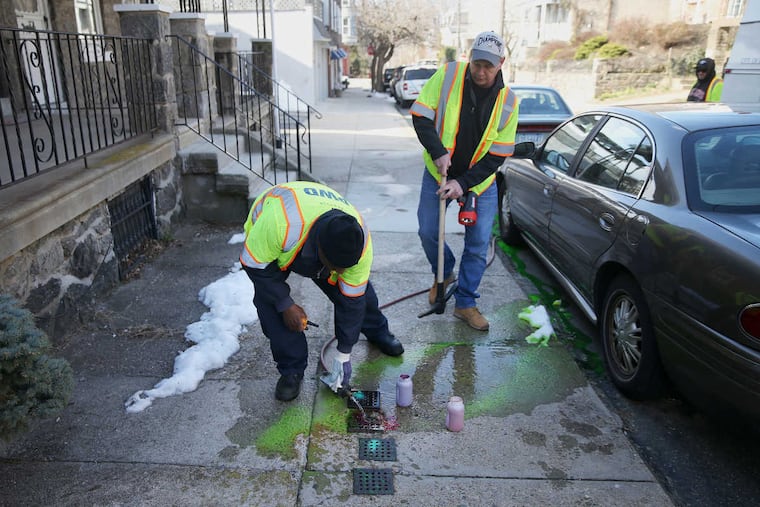At some Philly homes, toilets get flushed into the city's drinking water source. The underground detectives are on the case
Workers check for defects known as cross connections - essentially plumbing systems that were inadvertently reversed.

Two weeks ago, Joe Ferretti, a Philadelphia Water Department supervisor, pried open a manhole cover next to a scenic Schuylkill River bank, flicked on a flashlight, and peered down.
Ferretti saw evidence that sewage was flowing freely into the river at a stone outfall known as S050204.
In some Philadelphia homes, human waste, shower water, dirty dish grease, and other stuff that belongs in the sanitary sewer system is going down the wrong pipe, sending it to waterways that feed the Delaware River — the city's primary source of drinking water. The city does filter and treat the water it draws from the river, so drinking water would not be contaminated. However, sewage in the river could pose a threat to people who swim in it.
For years, water department workers such as Ferretti have been on a painstaking hunt for "cross-connections," a mild-sounding name that means mixed-up pipes that can reroute sewage into sources of drinking water. Between showers, toilet flushes, and sink use, a typical Philadelphia resident uses up to 85 gallons of water a day. That equates to about 272 gallons a day for a typical Philadelphia home — and if there's a cross-connection, that could mean 100,000 gallons going into the river each year.
The stone outfall Ferretti examined — outfall S050204 — is at Kelly Drive in the city's East Falls section. Water department crews had methodically worked their way up to a block on Ainslie Street, about half a mile from the river, looking for the home, or homes, that were producing the sewage. On a bitterly cold day last week, the crew spent hours outside on their detective work, literally following their noses.
They opened manhole after manhole before they at last smelled sewage in one storm drain. Bingo. The crew had found the street that was the source.
That left finding the offending house — or houses. Ferretti and crew chief Curtis Sumpter popped open another manhole cover and peered down.
"You got debris, you got a flow there," Ferretti said, "It doesn't seem like much but there should be no flow at all. Sometimes you'll see [toilet] paper, feces — all kind of stuff."
The next step was to put green and red water-soluble dye in vents by the curbs of individual homes to follow the flow. If red showed where green should be, that marked a possible cross-connection.
How connections get crossed
A city as old as Philadelphia is no stranger to water issues related to ancient plumbing. But, oddly enough, cross-connections are an issue in newer systems — though here, "newer" can mean 1940s.
Philadelphia has two types of systems to handle what is delicately known as "sanitary waste" and storm runoff from homes: Roughly half the city is on one, half on the other.
The older one is a combined system where stormwater and sanitary waste flow together in a pipe to one of the city's three wastewater treatment plants. But during heavy rains, the plants can get overwhelmed and sanitary waste flows into waterways.
So the city mandated a newer system decades ago that calls for two separate pipes exiting a property. One contains sanitary waste and flows to a treatment plant. Another collects stormwater runoff from yards and roof gutters and channels it into waterways.
But, over the years, homeowners add new bathrooms and kitchens. They hire plumbers. They fix things themselves.
Sometimes, they just tap into the first pipe they hit. In many houses, the storm pipe runs under the house, back to front. The sanitary pipe is smaller and could run under the storm pipe. So the storm pipe becomes an easier target for a do-it-yourselfer or lazy plumber. But, by tapping into the wrong pipe, the homeowner inadvertently starts injecting sanitary waste into waterways.
A painstaking hunt
To find those cross-connections, the water department in 1995 created a dedicated unit of sewage detectives. Since then, the unit has performed 60,000 dye tests and located 1,440 cross-connections. Last year alone, workers performed 2,093 dye tests and found 39 bad connections.
The unit usually goes on the hunt after sewage or moving water is detected in outfall pipes at waterways when it has not rained for three days. Theoretically, storm drains should be dry at those times.
From there, workers launch a painstaking investigation to isolate the bad connection, working their way up a street from manhole to manhole, then home to home. Once they find a possible source, the homeowner is notified that crews will have to go inside.
"They literally go into the home and do that same dye test for every plumbing fixture in the property," said Ben Jewell, a water department manager.
In some cases, Jewell said, only one fixture might have a cross-connection and the fix might be relatively cheap — just a few hundred dollars. However, in some cases multiple drains or the entire system is cross-connected. That repair can run in the thousands.
Generally, if a cross-connection is outside the home, the city will contract with a plumber and pick up the cost. Homeowners are responsible if the bad connection is inside.
Reggie Williams, the cross-connection project manager, leads 16 workers in the unit. He said the group found a number of bad connections on Ainslie and other streets stemming from outfall S050204. Williams said this week that the crew will be in the neighborhood for a while.
Williams said the task is often like whack-a-mole. Crews might check a street for cross-connections, clear it, and move on. Later, they find that someone has again tapped into a wrong pipe and the search starts over.
"We don't get all the glamour. We're not sexy," Williams said. "We're a little tiny unit, but we have a huge impact on the environment."